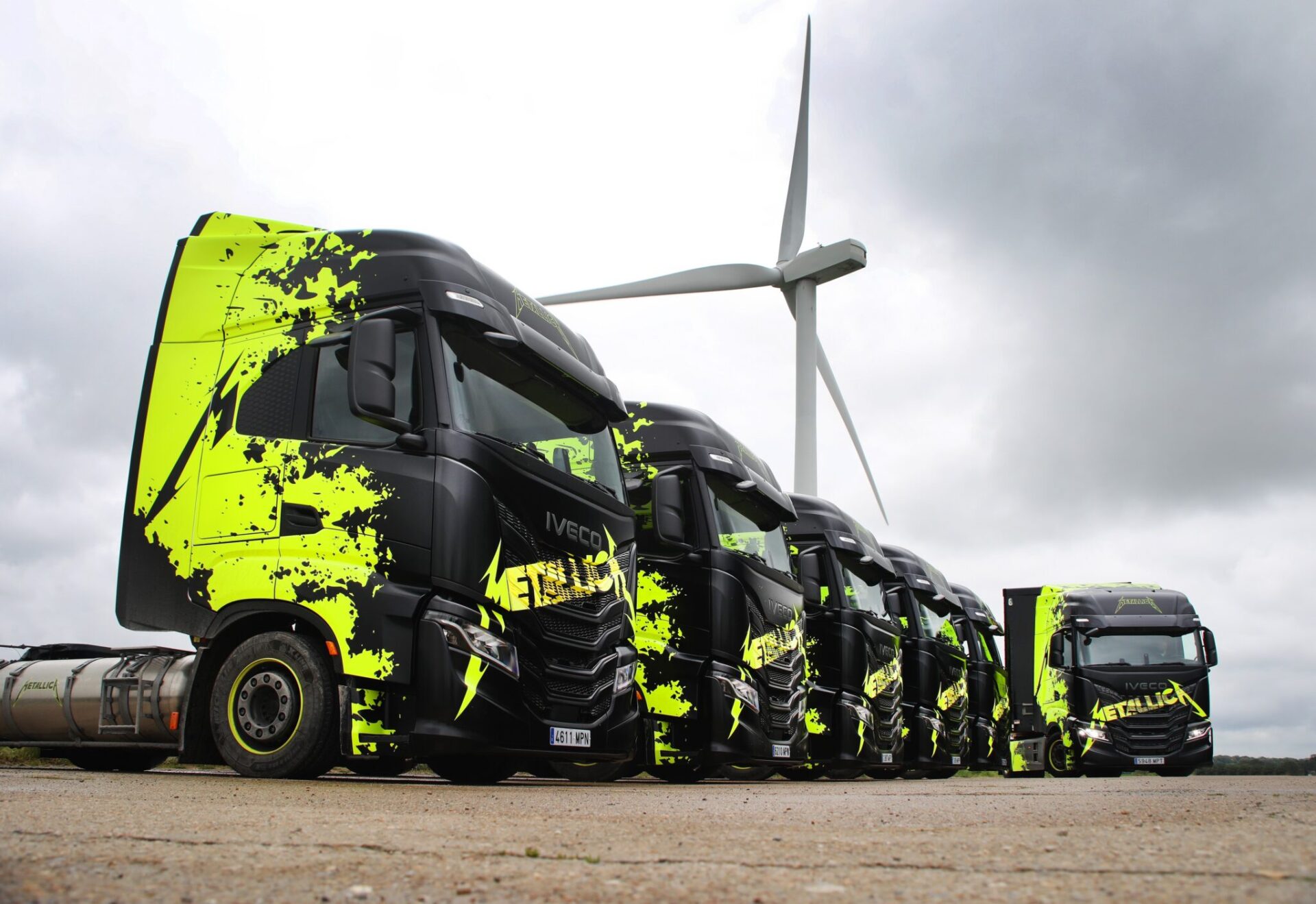The views expressed here are solely those of the author and do not necessarily represent the views of FreightWaves or its affiliates.
Remember “Fuel,” that iconic anthem by Metallica that celebrated the raw power of gasoline? I remember as I was rocking out to this song from the 1997 “Reload” album while I was in New Zealand driving an old beat-up Toyota van that was anything but sustainable.
Fast forward to 2024, and the band is taking a different approach, one that reflects a growing focus on sustainability. The European Union’s supply chain law is pushing companies, including rock bands, to embrace greener practices, and Metallica is leading the charge on the road with an eco-friendly tour.
Since beginning on May 24 in Munich, the band is journeying 7,200 miles across Europe. While Metallica’s iconic riffs and relentless drumbeats have blazed a trail in thrash metal, the group aims to do the same for sustainable trucking across European highways. Partnering with Iveco, a European truck maker, the band is replacing its gasoline-guzzling rigs with vehicles powered by biofuels like biomethane and vegetable oil.
Songs like “Battery” take on a new meaning in this context, showcasing Metallica’s commitment to a cleaner future. The tour’s heavy lifting will be handled by a fleet of 10 trucks powered by renewable natural gas and four running on biodiesel or hydrogenated vegetable oil. These vehicles can travel around 1,000 miles before refueling, a significant improvement over traditional diesel trucks in terms of emissions. However, clean technologies like battery-electric and hydrogen fuel cell trucks, which are heavily promoted by governments in Europe and the U.S., are still not viable for long distances due to the scarcity of charging and fueling stations.
The Metallica undertaking is a real-world experiment demonstrating the feasibility of sustainable long-haul trucking. Metallica’s effort is a powerful statement for sustainability but also a reminder of the challenges and limitations facing clean trucking technologies on a large scale. One of those limitations is the availability of the underlying infrastructure. We can identify big differences in investment, region by region and even country by country, in sustainable infrastructure.
We see major differences in investment between Europe, North America and Asia. The European Union’s ambitious Green Deal is driving significant investment in sustainable transportation. Many European countries are phasing out fossil fuel vehicles and are leaders in electric vehicle adoption, with the Scandinavian countries leading the way. While the U.S. lags Europe in some areas, there’s a growing focus on electric vehicle infrastructure and public transport improvements in major cities. Canada is also making strides in sustainable transportation investment. In Asia, China is a major player, investing heavily in high-speed rail and electric vehicle technology. Other Asian countries are at varying stages of development, with some focusing on expanding public transport networks and others prioritizing electric vehicle adoption.
One of the main challenges continues to be the high cost of infrastructure. Building sustainable infrastructure can require sustained government commitment and innovative financing models. Hence, many regions lack the infrastructure, such as charging stations for electric vehicles, to support sustainable transportation. Political commitment is crucial for long-term planning and investment in sustainable transportation. Regulators push for a shift toward battery-electric and hydrogen fuel cell technologies, but trucking companies find the costs prohibitive. The reality is that operating these vehicles can be two to three times more expensive than diesel and unrealistic for an industry with tight margins.
The key to wider adoption lies with consumer demand, according to many trucking executives. “Truckers will only adopt the technology when customers demand it,” one executive stated. At the recent American Trucking Associations’ 2024 Mid-Year Management Session, a panel discussed the road ahead for electric trucks.
“We’re all looking for efficiency — what’s going to be the most efficient solution, the most cost-effective,” said panelist Robert Sanchez, CEO of Ryder System Inc., whose company leases equipment to motor carriers. He said his customers are looking for cost data, reliability and simplicity when weighing the possibility of adding EVs to their operations. “None of those are what we’re getting with the technology that is out there right now,” he said.
A Ryder study published earlier this month — “Charged logistics: The cost of electric vehicle conversion for U.S. commercial fleets” — showed that the annual total cost to transport by electric vehicles versus diesel is estimated to increase across the board, ranging from up to 5% for a light-duty transit van to as much as 114% for a heavy-duty tractor, depending on the geographic area. For a mixed fleet of 25 light-, medium- and heavy-duty vehicles, the analysis showed an increased cost of up to 67% for an all-electric fleet.
J.B. Hunt President Shelley Simpson, speaking at the Advanced Clean Transportation Expo just a week ago, said zero-emissions truck technology is not ready for prime time. Electrification is not trucking’s best decarbonization option right now. Using examples from her own operation, she suggests fleets would do better by expanding the use of existing fuel-saving technologies, reducing empty and unproductive miles, and using biogenic fuels.
Metallica’s eco-friendly tour is a rock star example of what we all should be aiming for, but the reality is that it will take us years to put this into large-scale practice. Meantime, all we can do is rock on.
Look for more articles from me every week on FreightWaves.com.

About the author
Bart De Muynck is an industry thought leader with over 30 years of supply chain and logistics experience. He has worked for major international companies, including EY, GE Capital, Penske Logistics and PepsiCo, as well as several tech companies. He also spent eight years as a vice president of research at Gartner and, most recently, served as chief industry officer at project44. He is a member of the Forbes Technology Council and CSCMP’s Executive Inner Circle.


